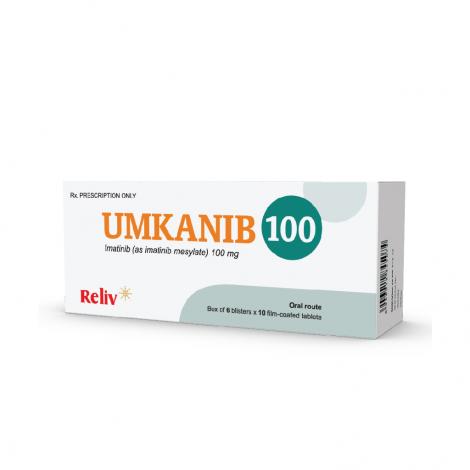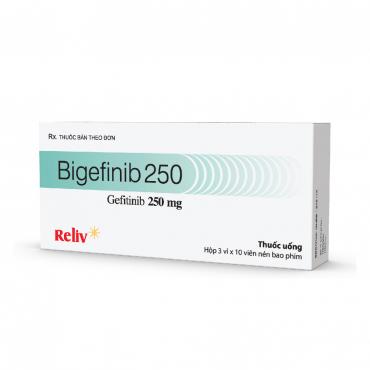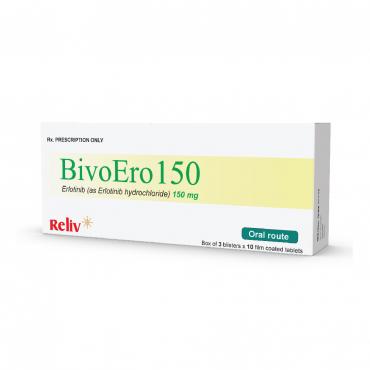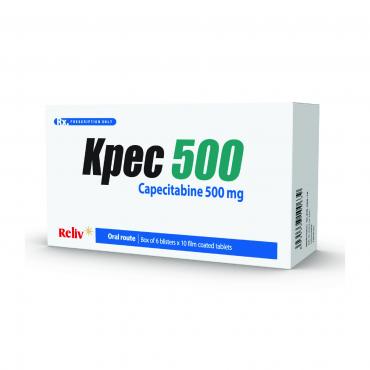Therapy should be initiated by a physician experienced in the treatment of patients with haematological malignancies and malignant sarcomas, as appropriate.
Posology for CML in adult patients
The recommended dosage of imatinib is 400 – 600 mg/day for adult patients in chronic phase CML
The recommended dosage of imatinib is 600 – 800 mg/day for adult patients in accelerated phase.
The recommended dose of imatinib is 600 mg/day for adult patients in blast crisis
Posology for CML in children
Dosing for children should be on the basis of body surface area (mg/m2). The dose of 340 mg/m2 daily is recommended for children with chronic phase CML and advanced phase CML (not to exceed the total dose of 800 mg). Treatment can be given as a once daily dose or alternatively the daily dose may be split into two administrations - one in the morning and one in the evening. The dose recommendation is currently based on a small number of paediatric patients. There is no experience with the treatment of children below 2 years of age.
Posology for Ph+ ALL in adult patients
The recommended dose of imatinib is 600 mg/day for adult patients with Ph+ ALL.
Posology for Ph+ ALL in children
Dosing for children should be on the basis of body surface area (mg/m2). The dose of 340 mg/m2 daily is recommended for children with Ph+ ALL (not to exceed the total dose of 600 mg).
Posology for MDS/MPD
The recommended dose of imatinib is 400 mg/day for adult patients with MDS/MPD.
Posology for HES/CEL
The recommended dose of imatinib is 100 mg/day for adult patients with HES/CEL.
Dose increase from 100 mg to 400 mg may be considered in the absence of adverse drug reactions if assessments demonstrate an insufficient response to therapy.
Treatment should be continued as long as the patient continues to benefit.
Posology for GIST
The recommended dose of imatinib is 400 mg/day for adult patients with unresectable and/or metastatic malignant GIST.
Limited data exist on the effect of dose increases from 400 mg to 600 mg or 800 mg in patients progressing at the lower dose
Posology for DFSP
The recommended dose of imatinib is 800 mg/day for adult patients with DFSP.
Method of administration/ CÁCH DÙNG
The prescribed dose should be administered orally with a meal and a large glass of water to minimise the risk of gastrointestinal irritations. Doses of 400 mg or 600 mg should be administered once daily, whereas a daily dose of 800 mg should be administered as 400 mg twice a day, in the morning and in the evening.
For patients unable to swallow the film-coated tablets, the tablets may be dispersed in a glass of still water or apple juice. The required number of tablets should be placed in the appropriate volume of beverage (approximately 50 ml for a 100 mg tablet, and 200 ml for a 400 mg tablet) and stirred with a spoon. The suspension should be administered immediately after complete disintegration of the tablet(s).
Dose adjustment:
Hepatic impairment: Imatinib is mainly metabolised through the liver. No need to require dose adjustment with patients with mild, moderate. Patients with severe liver dysfunction should be given reduce the dose by 25%. The dose can be reduced if not tolerated
Renal impairment: The recommended dose of imatinib should be reduced by 50% for patients with mild to moderate renal impairment (creatinine clearance 20 - 39 ml/min) and if tolerated, the dose can be increased for lack of efficacy. Do not use doses higher than 600 mg for patients with mild renal impairment (creatinine clearance 40 - 59 ml/min) and do not use doses higher than 400 mg for patients with moderate renal impairment. For patients with impaired renal function, caution must be used. It was reported that 2 cases were able to tolerate a dose of 100 mg/day, and the residual amount was equivalent to 400 mg/day in people without renal impairment.
Concomitant use of imatinib and medicinal products that induce CYP3A4 (e.g. dexamethasone, phenytoin, carbamazepine, rifampicin, phenobarbital or Hypericum perforatum, also known as St. John's Wort) may significantly reduce exposure to imatinib, potentially increasing the risk of therapeutic failure. If combined use is necessary, the dose should be increased by at least 50% and clinical response should be carefully monitored. Therefore, concomitant use of strong CYP3A4 inducers and imatinib should be avoided
Dose adjustment for adverse reactions
Non-haematological adverse reactions
If a severe non-haematological adverse reaction develops with imatinib use, treatment must be withheld until the event has resolved. Thereafter, treatment can be resumed as appropriate depending on the initial severity of the event.
If elevations in bilirubin >3x institutional upper limit of normal (IULN) or in liver transaminases >5x IULN occur, imatinib should be withheld until bilirubin levels have returned to <1.5x IULN and transaminase levels to <2.5x IULN. Treatment with imatinib may then be continued at a reduced daily dose. In adults the dose should be reduced from 400 to 300 mg or from 600 to 400 mg, or from 800 mg to 600 mg, and in children from 340 to 260 mg/m2/day.
Haematological adverse reactions
Dose reduction or treatment interruption for severe neutropenia and thrombocytopenia are recommended as indicated in the table below.
Dose adjustments for neutropenia and thrombocytopenia:
|
ASM/ HES/CEL (starting dose 100 mg) |
ANC <1.0 x 109/l and/or platelets <50 x 109/l |
1. Stop imatinib until ANC ≥ 1.5 x 109/l and platelets ≥ 75 x 109/l. 2. Resume treatment with imatinib at previous dose (i.e. before severe adverse reaction). |
|
Chronic Phase CML, MDS/MPD and GIST (starting dose 400 mg) HES/CEL (at dose 400 mg) |
ANC < 1,0 x 109/L and/or platelets <50 x 109/l |
1. Stop imatinib until ANC ≥ 1.5 x 109/l and platelets ≥ 75 x 109/l. 2. Resume treatment with imatinib at previous dose (i.e. before severe adverse reaction). 3. In the event of recurrence of ANC <1.0 x 109/l and/or platelets <50 x 109/l, repeat step 1 and resume imatinib at reduced dose of 300 mg. |
|
Paediatric chronic phase CML (at dose 340 mg/m2) |
ANC < 1,0 x 109/L and/or platelets <50 x 109/l
|
1. Stop imatinib until ANC ≥ 1.5 x 109/l and platelets ≥ 75 x 109/l. 2. Resume treatment with imatinib at previous dose (i.e. before severe adverse reaction). 3. In the event of recurrence of ANC < 1.0 x 109/l and/or platelets <50 x 109/l, repeat step 1 and resume imatinib at reduced dose of 260 mg/m2. |
|
Accelerated phase CML and blast crisis and Ph+ ALL (starting dose 600 mg)
|
aANC <0.5 x 109/l and/or platelets <10 x 109/l
|
1. Check whether cytopenia is related to leukaemia (marrow aspirate or biopsy). 2. If cytopenia is unrelated to leukaemia, reduce dose of imatinib to 400 mg 3. If cytopenia persists for 2 weeks, reduce further to 300 mg. 4. If cytopenia persists for 4 weeks and is still unrelated to leukaemia, stop imatinib until ANC ≥ 1 x 109/l and platelets ≥ 20 x 109/l, then resume treatment at 300 mg.
|
|
Paediatric accelerated phase CML and blast crisis (starting dose 340 mg/m2) |
aANC <0.5 x 109/l and/or platelets <10 x 109/l
|
1. Check whether cytopenia is related to leukaemia (marrow aspirate or biopsy). 2. If cytopenia is unrelated to leukaemia, reduce dose of imatinib to 260 mg/m2. 3. If cytopenia persists for 2 weeks, reduce further to 200 mg/m2. 4. If cytopenia persists for 4 weeks and is still unrelated to leukaemia, stop imatinib until ANC ≥ 1 x 109/l and platelets ≥ 20 x 109/l, then resume treatment at 200 mg/m2. |
|
DFSP (at dose 800 mg)
|
ANC <1.0 x 109/l and/or platelets <50 x 109/l
|
1. Stop imatinib until ANC ≥ 1.5 x 109/l and platelets ≥ 75 x 109/l. 2. Resume treatment with imatinib at 600 mg. 3. In the event of recurrence of ANC <1.0 x 109/l and/or platelets <50 x 109/l, repeat step 1 and resume imatinib at reduced dose of 400 mg. |
ANC=absolute neutrophil count
a occurring after at least 1 month of treatment
Special populations
Paediatric use: There is no experience in children with CML below 2 years of age and with Ph+ ALL below 1 year of age. There is very limited experience in children with MDS/MPD, DFSP, GIST and HES/CEL.
Elderly: No specific dose recommendation is necessary in elderly.
Hypersensitivity to the active substance or to any of the excipients of this drug.
Hypothyroidism
Clinical cases of hypothyroidism have been reported in thyroidectomy patients undergoing levothyroxine replacement during treatment with imatinib. Thyroid-stimulating hormone (TSH) levels should be closely monitored in such patients.
Hepatotoxicity
Metabolism of imatinib is mainly hepatic, and only 13% of excretion is through the kidneys. In patients with hepatic dysfunction (mild, moderate or severe), peripheral blood counts and liver enzymes should be carefully monitored. It should be noted that GIST patients may have hepatic metastases which could lead to hepatic impairment.
Cases of liver injury, including hepatic failure and hepatic necrosis, have been observed with imatinib. When imatinib is combined with high dose chemotherapy regimens, an increase in serious hepatic reactions has been detected. Hepatic function should be carefully monitored in circumstances where imatinib is combined with chemotherapy regimens also known to be associated with hepatic dysfunction.
Fluid retention
Occurrences of severe fluid retention (pleural effusion, oedema, pulmonary oedema, ascites, superficial oedema) have been reported in approximately 2.5% of newly diagnosed CML patients taking imatinib. Therefore, it is highly recommended that patients be weighed regularly. An unexpected rapid weight gain should be carefully investigated and if necessary appropriate supportive care and therapeutic measures should be undertaken. In clinical trials, there was an increased incidence of these events in elderly and those with a prior history of cardiac disease. Therefore, caution should be exercised in patients with cardiac dysfunction.
Patients with cardiac disease
Patients with cardiac disease, risk factors for cardiac failure or history of renal failure should be monitored carefully, and any patient with signs or symptoms consistent with cardiac or renal failure should be evaluated and treated.
In patients with hypereosinophilic syndrome (HES) with occult infiltration of HES cells within the myocardium, isolated cases of cardiogenic shock/left ventricular dysfunction have been associated with HES cell degranulation upon the initiation of imatinib therapy. The condition was reported to be reversible with the administration of systemic steroids, circulatory support measures and temporarily withholding imatinib. As cardiac adverse events have been reported uncommonly with imatinib, a careful assessment of the benefit/risk of imatinib therapy should be considered in the HES/CEL population before treatment initiation.
Myelodysplastic/myeloproliferative diseases with PDGFR gene re-arrangements could be associated with high eosinophil levels. Evaluation by a cardiology specialist, performance of an echocardiogram and determination of serum troponin should therefore be considered in patients with HES/CEL, and in patients with MDS/MPD associated with high eosinophil levels before imatinib is administered. If either is abnormal, follow-up with a cardiology specialist and the prophylactic use of systemic steroids (1-2 mg/kg) for one to two weeks concomitantly with imatinib should be considered at the initiation of therapy.
Gastrointestinal haemorrhage
In the study in patients with unresectable and/or metastatic GIST, both gastrointestinal and intra-tumoural haemorrhages were reported. Based on the available data, no predisposing factors (e.g. tumour size, tumour location, coagulation disorders) have been identified that place patients with GIST at a higher risk of either type of haemorrhage. Since increased vascularity and propensity for bleeding is a part of the nature and clinical course of GIST, standard practices and procedures for the monitoring and management of haemorrhage in all patients should be applied.
In addition, gastric antral vascular ectasia (GAVE), a rare cause of gastrointestinal haemorrhage, has been reported in post-marketing experience in patients with CML, ALL and other diseases. When needed, discontinuation of Imatinib treatment may be considered.
Laboratory tests
Complete blood counts must be performed regularly during therapy with imatinib. Treatment of CML patients with imatinib has been associated with neutropenia or thrombocytopenia. However, the occurrence of these cytopenias is likely to be related to the stage of the disease being treated and they were more frequent in patients with accelerated phase CML or blast crisis as compared to patients with chronic phase CML. Treatment with imatinib may be interrupted or the dose may be reduced, as recommended in section 4.2.
Liver function (transaminases, bilirubin, alkaline phosphatase) should be monitored regularly in patients receiving imatinib.
In patients with impaired renal function, imatinib plasma exposure seems to be higher than that in patients with normal renal function, probably due to an elevated plasma level of alpha-acid glycoprotein (AGP), an imatinib-binding protein, in these patients. Patients with renal impairment should be given the minimum starting dose. Patients with severe renal impairment should be treated with caution. The dose can be reduced if not tolerated.
Long-term treatment with imatinib may be associated with a clinically significant decline in renal function. Renal function should therefore be evaluated prior to the start of Imatinib therapy and closely monitored during therapy, with particular attention to those patients exhibiting risk factors for renal dysfunction. If renal dysfunction is observed, appropriate management and treatment should be prescribed in accordance with standard treatment guidelines.
Paediatric population
There have been case reports of growth retardation occurring in children and pre-adolescents receiving imatinib. In an observational study in the CML paediatric population, a statistically significant decrease (but of uncertain clinical relevance) in median height standard deviation scores after 12 and 24 months of treatment was reported in two small subsets irrespective of pubertal status or gender. Close monitoring of growth in children under imatinib treatment is recommended.








